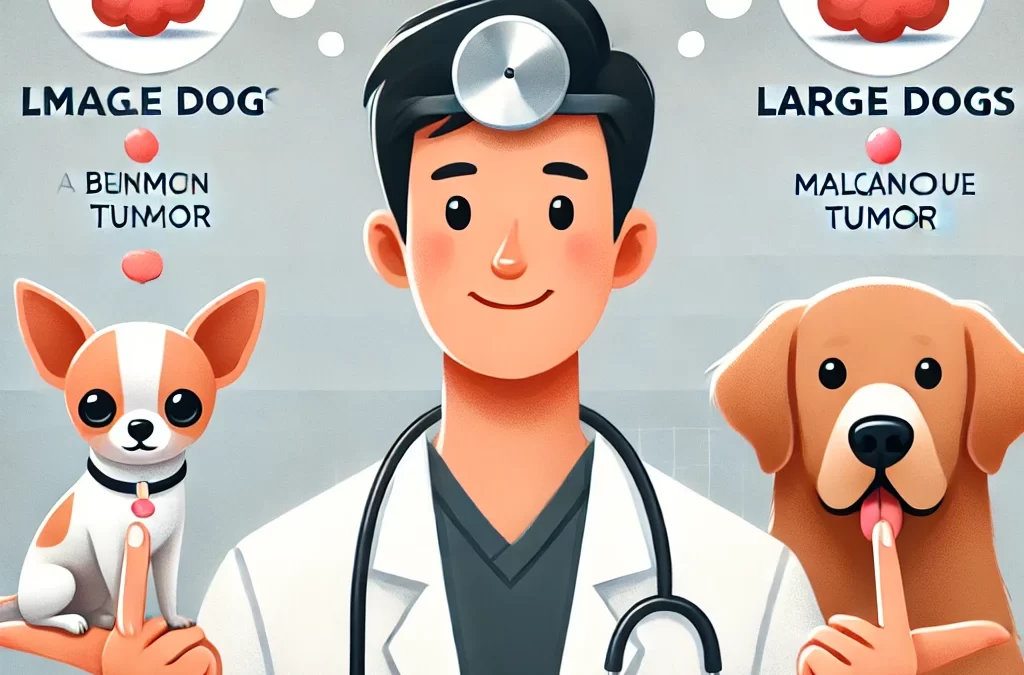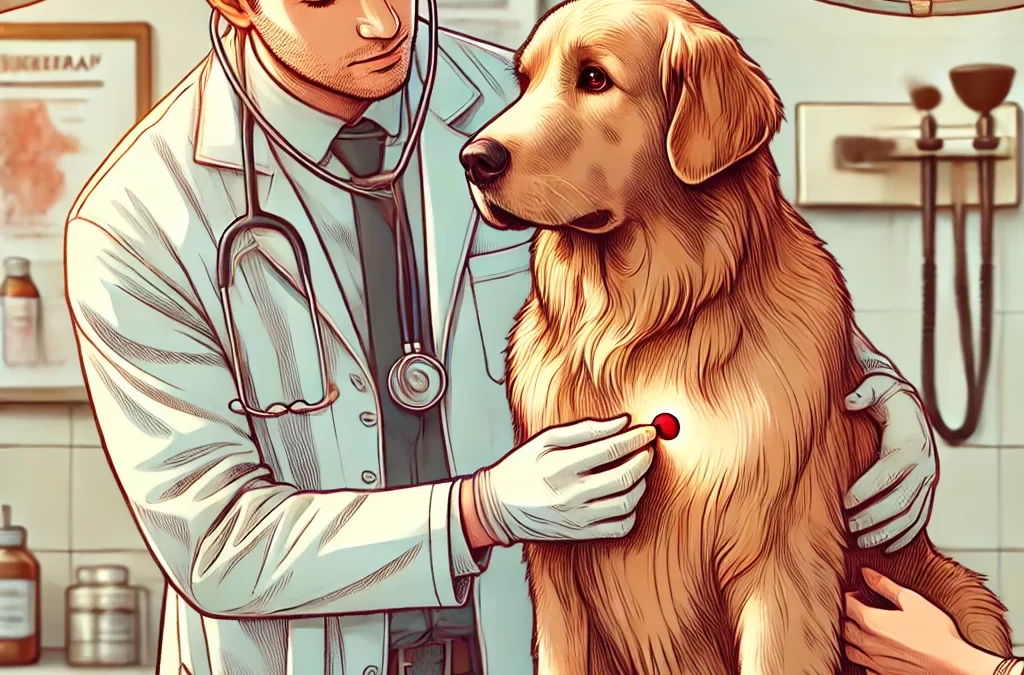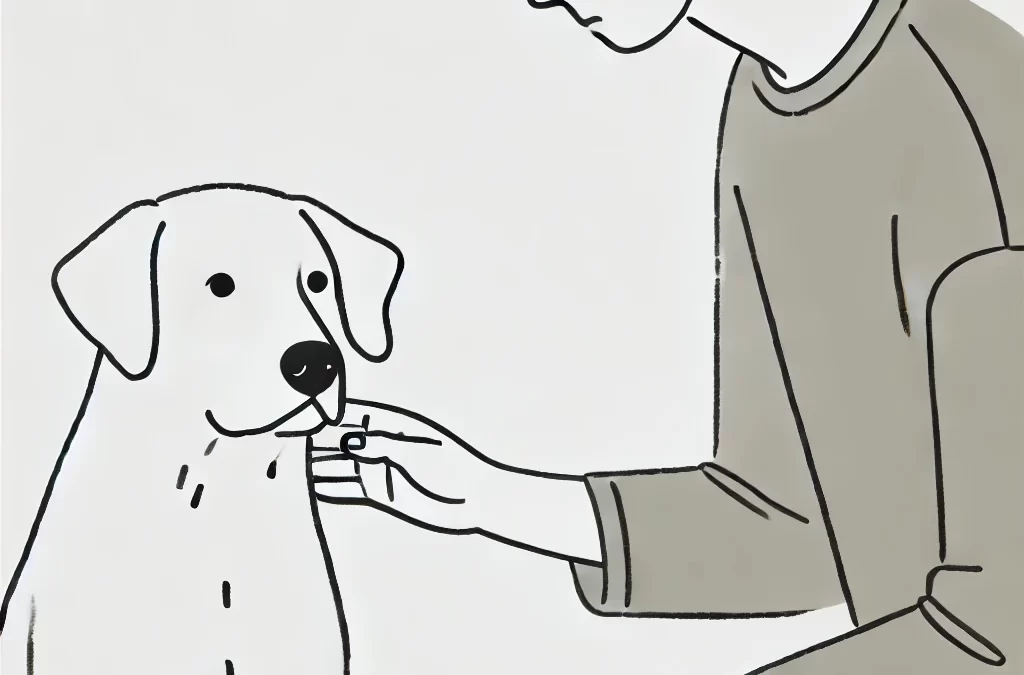
von TCMVET | 21. Januar 2025 | Krebs und Tumore bei Hunden
Zu sehen, wie ein geliebter Hund gegen Krebs im Endstadium kämpft, ist eine emotionale und herzzerreißende Reise. Eine Heilung ist zwar möglicherweise nicht möglich, aber es gibt Möglichkeiten, den Komfort zu erhöhen, die Schmerzen zu lindern und die verbleibende Lebensqualität zu verbessern. Dieser Artikel untersucht praktische, mitfühlende und sogar alternative Ansätze zur Unterstützung von Hunden mit Krebs im Endstadium.
1. Schmerzbehandlung priorisieren
Schmerzlinderung ist der Eckpfeiler der Behandlung von Krebs im Spätstadium. Zu den herkömmlichen Schmerzbehandlungsoptionen gehören:
- Verschreibungspflichtige Schmerzmittel – NSAR (nichtsteroidale Antirheumatika) und Opioide (wie Tramadol) helfen, Schmerzen wirksam zu lindern.
- Ergänzende Therapien – Gabapentin gegen Nervenschmerzen und Amantadin als NMDA-Antagonist können in Kombination mit anderen Schmerzmitteln den Komfort verbessern.
- CBD-Öl und pflanzliche Heilmittel – Viele Tierbesitzer greifen auf CBD-Vollspektrumöl, Kurkuma und Boswellia zurück, um Entzündungen und Schmerzen auf natürliche Weise zu lindern.
2. Ernährungsunterstützung zur Stärkung der Vitalität
Eine auf Krebs abgestimmte Ernährung kann das Fortschreiten der Krankheit verlangsamen und das allgemeine Wohlbefinden verbessern. Bedenken Sie:
- Hochwertiges Protein – Mageres Fleisch und Fisch liefern essentielle Aminosäuren für den Muskelerhalt.
- Gesunde Fette – Omega-3-Fettsäuren aus Fischöl helfen, Entzündungen zu reduzieren und können das Tumorwachstum verlangsamen.
- Kohlenhydratarme, ballaststoffreiche Ernährung – Krebszellen leben von Zucker, daher kann eine Reduzierung der Kohlenhydrataufnahme das Fortschreiten des Krebses verlangsamen.
- Natürliche Ergänzungsmittel – Heilpilze wie Corianderpilz und Reishi sowie chinesische Kräuter wie Tragant können das Immunsystem unterstützen.
3. Ganzheitliche Therapien für Komfort und Mobilität
Über Medikamente und Ernährung hinaus können ganzheitliche Behandlungen zusätzliche Linderung verschaffen:
- Akupunktur – Hilft, Schmerzen zu lindern, die Beweglichkeit zu verbessern und den Energiehaushalt anzuregen.
- Nachrichtentherapie – Eine sanfte Massage fördert die Durchblutung und lindert Steifheit.
- Hydrotherapie – Die Warmwassertherapie lindert den Gelenkdruck und fördert sanfte Übungen.
- Energieheilung und Reiki – Einige Tierbesitzer versuchen, sich mit Energieheilung zu entspannen und Stress abzubauen.
4. Schaffen Sie eine angenehme Umgebung
Die Anpassung des Lebensraums Ihres Hundes kann einen großen Unterschied machen:
- Weiche Bettwaren und orthopädische Stützen – Memory Foam-Betten reduzieren Druckgeschwüre und Gelenkschmerzen.
- Temperaturregelung – Ältere, kränkliche Hunde haben Probleme mit der Temperaturregulierung, daher ist es wichtig, sie im Winter warm und im Sommer kühl zu halten.
- Stress minimieren – Eine ruhige, friedliche Umgebung mit vertrauten Gerüchen kann Ängste und Schmerzen lindern.
5. Verdauungsprobleme und Flüssigkeitszufuhr bewältigen
Krebs kann zu Übelkeit, Durchfall und Appetitlosigkeit führen. Die Behandlung dieser Symptome trägt zur Verbesserung des Wohlbefindens bei:
- Appetite Stimulants – Medikamente wie Mirtazapin können das Essen fördern.
- Hausgemachte Knochenbrühen – Magenschonend, nährstoffreich und feuchtigkeitsspendend.
- Probiotika und Verdauungsenzyme – Unterstützt die Darmgesundheit und unterstützt die Verdauung.
- Regelmäßige Flüssigkeitszufuhr – Eine ausreichende Wasseraufnahme beugt Dehydrierung vor und unterstützt die Nierenfunktion.
6. Emotionale Unterstützung und Momente der Verbundenheit
Ihre Anwesenheit ist für einen Hund in seiner letzten Phase einer der größten Trostpunkte. Verbringen Sie Zeit miteinander:
- Beschäftigen Sie sich mit Ihren Lieblingsbeschäftigungen – Ein kurzer Spaziergang, eine Autofahrt oder eine ruhige Kuschelstunde können Freude bereiten.
- Sprechen Sie mit Ihrem Hund – Der Klang Ihrer Stimme wirkt beruhigend und entspannend.
- Seien Sie ohne Angst präsent – Hunde spüren Emotionen. Eine friedliche und liebevolle Energie gibt ihnen daher ein Gefühl der Sicherheit.
7. Wissen, wann man sich verabschieden muss
Eine der schwierigsten Entscheidungen ist die Feststellung, wann Sterbehilfe die mitfühlendste Lösung ist. Bedenken Sie:
- Die HHHHHMM-Skala – Diese von Dr. Alice Villalobos entwickelte Lebensqualitätsbeurteilung misst Schmerzen, Hunger, Flüssigkeitszufuhr, Hygiene, Glück, Mobilität und mehr gute als schlechte Tage.
- Tierhospiz und Euthanasie zu Hause – Viele Tierärzte bieten Dienstleistungen zu Hause an, um einen ruhigen Übergang in einer vertrauten Umgebung zu ermöglichen.
- Auf den Hund hören – Verhaltensänderungen, anhaltende Schmerzen trotz Medikamenten oder ein völliger Appetitverlust können darauf hinweisen, dass es Zeit ist.
Abschluss
Die Pflege eines Hundes mit Krebs im Endstadium ist eine tiefgreifende Erfahrung voller Liebe, Hingabe und Mitgefühl. Indem sie sich auf Schmerzbehandlung, Ernährungsunterstützung, ganzheitliche Therapien und emotionales Wohlbefinden konzentrieren, können Tierbesitzer sicherstellen, dass die verbleibenden Tage ihres Hundes von Trost und Würde erfüllt sind. Ob Sie sich für Palliativpflege entscheiden oder schließlich die schwierige Entscheidung treffen, Abschied zu nehmen, das Ziel bleibt dasselbe: die Bindung zu ehren und ihnen die bestmögliche Lebensqualität zu geben.

von TCMVET | 20. Januar 2025 | Krebs und Tumore bei Hunden
Wenn es um Krebs und Tumorentwicklung bei Hunden geht, kommt es buchstäblich auf die Größe an. Kleine und große Rassen haben unterschiedliche genetische Veranlagungen, Stoffwechselraten und Immunreaktionen, die alle zu Unterschieden in der Entwicklung, dem Fortschreiten und der Reaktion von Tumoren auf die Behandlung beitragen. Wenn Sie ein Tierhalter sind, der sich um die Gesundheit Ihres Hundes sorgt, kann Ihnen das Verständnis dieser Unterschiede dabei helfen, fundierte Entscheidungen über Prävention, Früherkennung und Behandlung zu treffen.
1. Der genetische Faktor: Rassespezifische Tumorrisiken
Einige Krebsarten treten bei bestimmten Rassen häufiger auf, und die Größe des Hundes spielt bei dieser Veranlagung oft eine Rolle.
- Große Rassen: Hunde wie Golden Retriever, Deutsche Doggen und Rottweiler entwickeln häufiger Osteosarkom (Knochenkrebs), Hämangiosarkom (Blutgefäßkrebs) und LymphomDiese Krebsarten neigen dazu, aggressiv zu sein und metastasieren oft schnell.
- Kleine Rassen: Rassen wie Pudel, Dackel und Chihuahuas sind anfälliger für gutartige Tumoren wie Lipome und Papillome, aber sie können auch entwickeln Brusttumore und Blasenkrebs.
Die Unterschiede liegen nicht nur in der Art des Tumors, sondern auch darin, wie sich diese Krebsarten verhalten und auf die Behandlung reagieren.
2. Tumorwachstumsrate und -verhalten
Aufgrund unterschiedlicher Wachstumsgeschwindigkeiten und des Zellstoffwechsels variiert die Tumorentwicklung bei kleinen und großen Hunden erheblich.
- Schnelleres Wachstum bei großen Hunden: Größere Rassen wachsen als Welpen schnell, und diese schnelle Zellteilung kann zu einem höheren Risiko für die Entwicklung beitragen bösartige Tumoren später im Leben. Ihre Tumore neigen auch dazu, aggressiver zu sein.
- Langsameres Wachstum bei kleinen Hunden: Obwohl sich Tumore bei kleinen Rassen möglicherweise langsamer entwickeln, sind sie dennoch besorgniserregend. Gutartige Tumoren wie Lipome sind häufig, können aber die Beweglichkeit beeinträchtigen, wenn sie zu groß werden. Darüber hinaus können kleine Hunde immer noch bösartige Tumore entwickeln, wie Mastzelltumoren, das sich ausbreiten kann, wenn es unbehandelt bleibt.
3. Lebenserwartung und Tumorbeginn
Große Hunde haben tendenziell eine kürzere Lebenserwartung als kleine Hunde, was sich auf den zeitlichen Ablauf der Tumorentwicklung auswirkt.
- Früh auftretende Krebserkrankungen bei großen Hunden: Da große Rassen schneller altern, erkranken sie häufiger in jüngerem Alter an Krebs – oft zwischen 6 bis 8 Jahre. Das bedeutet, dass Besitzer frühzeitig mit Krebsvorsorgeuntersuchungen und Vorsorgeuntersuchungen beginnen sollten.
- Später auftretende Tumoren bei kleinen Hunden: Kleine Rassen zeigen möglicherweise erst dann Anzeichen von Krebs, wenn ihre Oberstufe (10+ Jahre), weshalb eine langfristige Überwachung unerlässlich ist.
Die Kenntnis dieser Zeitabläufe kann Tierbesitzern dabei helfen, rechtzeitig Tierarztuntersuchungen einzuplanen, um mögliche Tumore frühzeitig zu erkennen.
4. Herausforderungen bei Diagnose und Behandlung
Bei der Diagnose und Behandlung von Tumoren spielt die Größe sowohl für die Erkennung als auch für die Durchführung von Eingriffen eine Rolle.
- Chirurgische Überlegungen: Große Hunde vertragen einige Operationen aufgrund ihrer größeren Körpermasse besser, aber die Entfernung von Tumoren in gewichttragenden Knochen (wie bei Osteosarkomen) kann eine Herausforderung darstellen. Kleine Hunde hingegen können mit den Narkoserisiken zu kämpfen haben, insbesondere wenn sie sehr klein sind.
- Unterschiede zwischen Chemotherapie und Medikamenten: Die Dosierung der Chemotherapie ist gewichtsabhängig, und größere Hunde benötigen oft höhere Medikamentendosen, was die Behandlungskosten erhöht. Kleine Hunde benötigen zwar geringere Dosen, können aber aufgrund ihres empfindlichen Organismus stärkere Nebenwirkungen erfahren.
5. Präventions- und Früherkennungsstrategien
Unabhängig von der Größe ist eine frühzeitige Erkennung entscheidend. Folgendes können Hundebesitzer tun:
- Routinemäßige tierärztliche Untersuchungen: Regelmäßige Untersuchungen helfen, Tumore zu erkennen, bevor sie zu groß werden.
- Körperliche Untersuchungen zu Hause: Wenn Sie wöchentlich mit den Händen über den Körper Ihres Hundes fahren, können Sie ungewöhnliche Knoten entdecken.
- Rassespezifische Krebsvorsorgeuntersuchungen: Bei großen Rassen sollten frühzeitig Röntgen- und Ultraschalluntersuchungen durchgeführt werden, während bei kleinen Rassen Haut- und Blasenuntersuchungen von Vorteil sein können.
- Anpassungen der Ernährung und des Lebensstils: Eine ausgewogene Ernährung, regelmäßige Bewegung und Gewichtskontrolle können die allgemeine Gesundheit unterstützen und möglicherweise das Krebsrisiko senken.
Abschließende Gedanken
Tumore können sowohl bei kleinen als auch bei großen Hunden auftreten. Aufgrund der Unterschiede in Genetik, Tumorverhalten und Behandlungsmöglichkeiten benötigen Tierhalter jedoch maßgeschneiderte Pflegestrategien. Große Hunde sind in jüngerem Alter anfälliger für aggressive Krebserkrankungen, während kleine Hunde später im Leben langsamer wachsende Tumore entwickeln können. Wenn Hundehalter diese Unterschiede verstehen und einer Früherkennung Priorität einräumen, können sie die Lebensqualität ihrer Haustiere verbessern und möglicherweise ihre gemeinsame Zeit verlängern.

von TCMVET | 20. Januar 2025 | Krebs und Tumore bei Hunden
Stellen Sie sich vor: Sie haben Ihrem Hund nach einem vergnüglichen Spaziergang gerade eine wohlverdiente Bauchkraulung verpasst. Plötzlich berühren Ihre Fingerspitzen eine kleine Beule, die Ihnen vorher noch nie aufgefallen ist. Jetzt erklingt die spannende Musik – Hat ein außerirdischer Eindringling (sprich: ein bösartiger Tumor) sein Lager aufgeschlagen oder ist es nur ein harmloser Hausbesetzer (gutartiges Geschwür), der sich unter der Haut Ihres Hundes versteckt? Bevor Sie Alarm schlagen oder es einfach abtun, wollen wir etwas Licht in die Sache bringen, wie Sie diese mysteriösen neuen Bewohner im Körper Ihres pelzigen Freundes entschlüsseln können.
1. „Growth CSI“: Forensische Hinweise, die wichtig sind
Stellen Sie sich vor, Sie wären der Detektiv in einem spannenden Krimi. Ihre Aufgabe ist es, alle Beweise zu sammeln:
- Textur und Mobilität: Bösartige Tumore fühlen sich oft unregelmäßig an und können mit dem umgebenden Gewebe verkleben, während gutartige Knoten tendenziell glatter und beweglicher sind.
- Wachstumsrate: Bläst sich die Beule schnell auf wie ein Ballon oder bleibt sie über Wochen oder Monate gleich groß? Schnelleres Wachstum kann auf eine bösartige Erkrankung hinweisen.
- Zugehörige Symptome: Appetitveränderungen, Lethargie, Gewichtsverlust oder lokalisierte Schmerzen können weitere Warnzeichen sein, die sofortige Aufmerksamkeit erfordern.
Die wichtigste Erkenntnis? Ziehen Sie keine voreiligen Schlüsse, nur weil sich der Knoten anfühlt. Halten Sie Ihr „Detektivnotizbuch“ jedoch mit Beobachtungen auf dem neuesten Stand.
2. Wissenschaftliche Informationen: Diagnosetests enthüllen die Wahrheit
Wie bei jedem guten Thriller brauchen Sie einen qualifizierten Partner, um den Fall zu lösen. In dieser Folge ist das Ihr vertrauenswürdiger Tierarzt, bewaffnet mit High-Tech-Werkzeugen und einem scharfen Auge fürs Detail:
- Feinnadelaspiration (FNA): Ein schneller, minimalinvasiver Test, der unmittelbare zelluläre Hinweise liefern kann. Stellen Sie es sich so vor, als würden „Fingerabdrücke“ zur Identität des Knotens gesammelt.
- Biopsie: Manchmal ist ein genauerer Blick erforderlich – beispielsweise die Analyse der DNA eines Verdächtigen. Eine Biopsie bietet tiefere Einblicke in die Struktur und das Zellverhalten des Gewebes.
- Bildgebungswerkzeuge: Röntgenaufnahmen, Ultraschalluntersuchungen oder MRTs dienen dem Detektiv als Vergrößerungsglas und ermöglichen die Entdeckung versteckter Hinweise zu den Grenzen und der möglichen Ausbreitung des Wucherungsbefalls.
3. Tumor oder gutartiges Wachstum? Das Urteil verstehen
Nach der Beweisaufnahme und den Tests wird das Urteil gefällt. Bösartige Tumore – unsere „fremden Eindringlinge“ – bergen das Risiko der Infiltration und Metastasierung. Dies erfordert oft eine sofortige, manchmal aggressive Behandlung, die eine Operation, Chemotherapie oder Bestrahlung umfassen kann. Gutartige Wucherungen – unsere „harmlosen Hausbesetzer“ – wachsen im Allgemeinen langsam und bleiben begrenzt, aber das bedeutet nicht, dass man sie immer ignorieren kann. Einige gutartige Massen können dennoch auf lebenswichtige Organe drücken oder mit der Zeit Geschwüre bilden, die eine Entfernung oder regelmäßige Überwachung erforderlich machen.
4. Einen Behandlungs-Masterplan erstellen
Unabhängig davon, ob die Diagnose auf einen harmlosen Hausbesetzer oder einen bestätigten außerirdischen Eindringling lautet, ist eine solide Strategie unverzichtbar:
- Operative Entfernung: Oft die erste Verteidigungslinie – wie die Räumung eines schlechten Mieters.
- Medikamente & Therapien: Eine Chemotherapie, eine zielgerichtete Therapie oder eine Immuntherapie können den Ausschlag zugunsten Ihres Hundes geben, wenn der Tumor bösartig ist.
- Anpassungen des Lebensstils: Von speziellen Diäten bis hin zu sanften Trainingsroutinen hilft eine ganzheitliche Unterstützung Ihrem Hund, sich während der Behandlung optimal zu fühlen.
- Laufende Überwachung: Betrachten Sie dies als Ihre Perimeterpatrouille, um sicherzustellen, dass keine verdächtigen Klumpen wiederkehren oder anderswo auftauchen.
5. Erfolge feiern und den Weg gemeinsam gehen
Das Entdecken eines neuen Knotens kann eine beängstigende Wendung in der Geschichte Ihres geliebten Haustiers bedeuten. Aber denken Sie daran: Nicht jeder Knoten ist ein düsteres Szenario. Mit Wachsamkeit und einem proaktiven Ansatz können Sie dieses „Alien vs. Hausbesetzer“-Mysterium in eine überschaubare Nebenhandlung im Lebensabenteuer Ihres Hundes verwandeln. Informieren Sie Ihren Tierarzt über Neuigkeiten, feiern Sie kleine Erfolge (einen stabilen Knoten, eine erfolgreiche Operation, ein gutes Energieniveau) und freuen Sie sich über jedes Schwanzwedeln auf dem Weg.
Denn am Ende des Tages endet jeder erzählenswerte Krimi mit Hoffnung – und vielleicht ein paar zusätzlichen Leckerlis für den besten Kumpel der Welt: Ihren Hund.

von TCMVET | 18. Januar 2025 | Krebs und Tumore bei Hunden
Krebs bei Hunden ist eine gewaltige Herausforderung und wird oft zu spät diagnostiziert, um noch wirksam eingreifen zu können. Herkömmliche Diagnoseverfahren wie Biopsien und Bildgebung haben ihre Grenzen – sie können invasiv, kostspielig oder nicht in der Lage sein, Tumore im Frühstadium zu erkennen. Hier kommen Tumor-Biomarker ins Spiel: molekulare Signaturen, die in Blut, Urin oder Gewebe gefunden werden und einen bahnbrechenden Ansatz für die Hunde-Onkologie bieten. Mit Fortschritten in der Veterinärmedizin, die mit Durchbrüchen in der Human-Onkologie einhergehen, ist das Rennen um die Entwicklung zuverlässiger, nicht-invasiver Biomarker für Früherkennung, Echtzeitüberwachung und personalisierte Behandlungsstrategien eröffnet.
1. Was sind Tumor-Biomarker und warum sind sie wichtig?
Tumorbiomarker sind messbare biologische Substanzen, die das Vorhandensein, Fortschreiten oder Ansprechen auf die Behandlung von Krebs anzeigen. Dies können sein:
- Proteine und Enzyme: Erhöhte Werte bestimmter Proteine wie des C-reaktiven Proteins (CRP) oder der Thymidinkinase 1 (TK1) können auf bösartige Erkrankungen hinweisen.
- Zirkulierende Tumor-DNA (ctDNA): Im Blutkreislauf gefundene Fragmente von Tumor-DNA bieten Einblicke in genetische Mutationen und die Tumorlast.
- Exosomen und MicroRNAs (miRNAs): Winzige extrazelluläre Vesikel und nicht-kodierende RNAs erweisen sich als vielversprechende Instrumente für die Krebserkennung und -prognose.
Die Fähigkeit, Krebs zu erkennen, bevor er klinisch manifest wird, könnte die Behandlungsergebnisse und die Lebensqualität von Hunden drastisch verbessern.
2. Die Biomarker-Revolution: Vom Konzept zur klinischen Anwendung
2.1. Früherkennung: Der ultimative Wendepunkt
Krebs im Frühstadium verläuft oft symptomlos, was Routineuntersuchungen zu einer Herausforderung macht. Biomarker können diese Lücke schließen, indem sie bösartige Tumore lange vor dem Auftreten von Symptomen identifizieren.
- Hundespezifisches CRP und TK1: Erhöhte Werte wurden mit Lymphomen, Hämangiosarkomen und Mastzelltumoren in Verbindung gebracht.
- Serum-Mikro-RNAs: Bestimmte miRNA-Profile korrelieren stark mit Osteosarkomen und Brusttumoren und ebnen so den Weg für routinemäßige Bluttests zur Erkennung von Hochrisikofällen.
2.2. Prognostische Erkenntnisse: Ergebnisse präzise vorhersagen
Nicht alle Tumoren verhalten sich gleich. Biomarker helfen Tierärzten, zwischen aggressiven Krebsarten und langsam wachsenden Neoplasien zu unterscheiden und ermöglichen so maßgeschneiderte Behandlungsstrategien.
- Ki-67 und PCNA (Proliferationsmarker): Hohe Expressionsniveaus deuten auf schnelles Tumorwachstum und eine schlechtere Prognose hin.
- LDH (Laktatdehydrogenase): Erhöhte LDH-Werte weisen häufig auf Metastasen bei Hämangiosarkomen hin und sind Orientierung für die Behandlungsintensität.
2.3. Therapeutisches Monitoring: Behandlungsanpassungen in Echtzeit
Biomarker ermöglichen eine nicht-invasive Verfolgung der Tumorreaktion und geben Tierärzten die Möglichkeit, die Behandlung dynamisch anzupassen.
- Zirkulierende Tumor-DNA (ctDNA): Die Überwachung des ctDNA-Spiegels kann Aufschluss darüber geben, wie gut ein Hund auf eine Chemotherapie oder Bestrahlung anspricht.
- Profilierung von Exosomen: Veränderungen in der Zusammensetzung der Exosomenfracht nach der Behandlung geben Aufschluss über das Risiko einer Resterkrankung und eines Rückfalls.
3. Spitzentechnologien gestalten die Zukunft der Hundeonkologie
3.1. Künstliche Intelligenz (KI) trifft Biomarker
KI-gestützte Diagnosetools werden derzeit darauf trainiert, Biomarkermuster zu analysieren und nahezu sofortige, hochpräzise Bewertungen zu liefern. Stellen Sie sich einen KI-gesteuerten Bluttest vor, der das Krebsrisiko vorhersagt, bevor klinische Anzeichen auftreten!
3.2. Liquid Biopsy: Das Ende der invasiven Diagnostik?
Die Flüssigbiopsie, die ctDNA und exosomale Marker erkennt, könnte die Krebsdiagnostik revolutionieren. Im Gegensatz zu herkömmlichen Biopsien bietet sie eine minimalinvasive Momentaufnahme der Tumorentwicklung in Echtzeit.
3.3. Personalisierte Medizin für Hunde
Mit den Fortschritten in der Biomarkerforschung könnten Tierärzte schon bald in der Lage sein, biomarkergestützte Entscheidungen zu treffen und auf der Grundlage des individuellen Tumorprofils eines Hundes die beste Chemotherapie, Immuntherapie oder gezielte Behandlung auszuwählen.
4. Herausforderungen und ethische Überlegungen
Trotz aller Versprechungen gibt es bei der Biomarker-basierten Diagnostik noch einige Hürden:
- Standardisierungsprobleme: Biomarkerwerte können je nach Rasse, Alter und Begleiterkrankungen variieren.
- Kosten vs. Zugänglichkeit: Fortgeschrittene Biomarkertests sind immer noch teuer und nicht überall verfügbar.
- Falsch positive und negative Ergebnisse: Kein Biomarkertest ist 100%-narrensicher – um die Zuverlässigkeit zu gewährleisten, sind weitere Verfeinerungen erforderlich.
5. Fazit: Der Beginn einer neuen Ära in der Krebsbehandlung bei Hunden
Tumorbiomarker sind nicht mehr nur theoretische Werkzeuge – sie werden immer wichtiger für die Diagnose, Prognose und Behandlung von Krebs bei Hunden. Mit dieser molekularen Revolution beschreitet die Veterinärmedizin eine Zukunft, in der Krebs früher erkannt, präziser behandelt und mit beispielloser Genauigkeit überwacht wird.
Mit der Weiterentwicklung der Technologie könnte der Traum von einem einfachen Bluttest zum Nachweis mehrerer Krebsarten bei Hunden schon bald Wirklichkeit werden und Hunden und ihren Besitzern das kostbare Geschenk von mehr Zeit und einer besseren Lebensqualität machen.

von TCMVET | 18. Januar 2025 | Krebs und Tumore bei Hunden
Die Welt der Veterinäronkologie erlebt einen dramatischen Wandel, da Spitzentechnologie und visionäre Forschung zusammenkommen, um unseren Ansatz bei Hirntumoren bei Hunden zu verändern. Während sich die Praktiker lange Zeit an konventionellen Diagnosemethoden und traditionellen Behandlungsmodalitäten orientiert haben, verspricht eine neue Ära der Innovation, klinische Ergebnisse neu zu definieren und unser Verständnis dieser komplexen Erkrankungen zu verbessern. Im Folgenden untersuchen wir, wie hochmoderne Diagnosewerkzeuge, künstliche Intelligenz und der wachsende Einfluss der stereotaktischen Radiochirurgie (SRS) die Grenzen der Neuroonkologie bei Hunden erweitern.
- Von den Symptomen zum Verdacht: Die sich entwickelnde diagnostische Landschaft
1.1. Das Ungewöhnliche erkennen
Bisher beruhte die Erkennung von Hirntumoren bei Hunden auf der Erkennung subtiler neurologischer Anzeichen – wie anhaltender Kopfschiefhaltung, Ataxie und Verhaltens- oder Appetitveränderungen. Diese Warnsignale sind nach wie vor wichtig, doch moderne Bildgebung und Datenanalyse bieten eine differenziertere Perspektive. Dank hochauflösender Bildgebung und verfeinerter Diagnosealgorithmen können Ärzte heute besser zwischen entzündlichen Erkrankungen, Infektionen und Neoplasien unterscheiden.
1.2. Der Aufstieg der modernen Bildgebung
• Hochfeld-MRT: Das Hochfeld-MRT gilt als Goldstandard für die Visualisierung intrakranieller Läsionen und liefert detaillierte Bilder von Weichgewebe und Läsionsgrenzen. Die neuesten MRT-Sequenzen, darunter funktionelles MRT (fMRI) und Diffusions-Tensor-Bildgebung (DTI), können tiefer in die Tumorbiologie eintauchen und mikrostrukturelle Veränderungen aufdecken, bevor makroskopische Anomalien auftreten.
• Magnetresonanzspektroskopie (MRS): MRS bietet Einblicke auf molekularer Ebene durch die Bewertung metabolischer Veränderungen im Tumor. Erhöhte Cholin- und Laktatspitzen können beispielsweise als Frühwarnzeichen für Bösartigkeit oder aggressives Wachstum dienen.
• KI-gestützte Bildanalyse: Innovative Algorithmen auf Basis künstlicher Intelligenz ermöglichen es, Tumorwachstum mit bemerkenswerter Geschwindigkeit und Genauigkeit zu erkennen und zu quantifizieren. Diese Tools können klinische Daten, Bildmarker und histopathologische Befunde integrieren, um das wahrscheinliche Fortschreiten eines Tumors oder die Reaktion auf die Behandlung vorherzusagen.
1.3. Biopsie und darüber hinaus
Obwohl sich die Bildgebungstechnologie erheblich weiterentwickelt hat, bleibt die histopathologische Bestätigung eine tragende Säule der endgültigen Diagnose. Stereotaktische Biopsietechniken minimieren die Invasivität, verringern Komplikationen und beschleunigen die Genesung. In naher Zukunft könnte die Flüssigbiopsie – die Analyse zirkulierender Tumorzellen oder Tumor-DNA im Blutkreislauf – den Bedarf an invasiven Verfahren weiter reduzieren und den Weg für eine Echtzeit-Tumorüberwachung und dynamische Behandlungsanpassungen ebnen.
- Der Quantensprung: Stereotaktische Radiochirurgie
2.1. Die Grenzen der konventionellen Strahlentherapie durchbrechen
Jahrzehntelang war die externe Strahlentherapie die Standardmethode zur Behandlung inoperabler oder chirurgisch anspruchsvoller Hirntumore bei Hunden. Obwohl sie in bestimmten Fällen wirksam war, waren oft mehrere Sitzungen über mehrere Wochen hinweg erforderlich. Hier kommt die Stereotaktische Radiochirurgie (SRS) ins Spiel – eine präzisionsgesteuerte Technik, bei der dem Tumor in einer oder nur wenigen Sitzungen eine konzentrierte Strahlendosis zugeführt wird, wodurch die Schädigung des umliegenden gesunden Gewebes minimiert wird.
2.2. Kennzeichen von SRS
• Höchste Präzision: Fortschrittliche Bildgebung und computergestützte Behandlungsplanung stellen sicher, dass der Strahlenstrahl nur auf den Tumor zielt und umliegende Strukturen schont.
• Weniger Behandlungssitzungen: Viele SRS-Protokolle für Hunde erfordern weniger Besuche und reduzieren so den Stress für Tier und Besitzer.
• Schnelle Linderung der Symptome: Hochdosierte Strahlung lässt den Tumor häufig schneller schrumpfen und bietet im Vergleich zur herkömmlichen fraktionierten Strahlentherapie eine schnellere Symptomkontrolle.
• Minimale Nebenwirkungen: Der gezielte Ansatz führt zu weniger strahlungsbedingten Komplikationen wie Hautreizungen oder Haarausfall.
2.3. Modernste Ausrüstung
Tierkliniken verwenden zunehmend Systeme, die früher der Humanmedizin vorbehalten waren, wie Gamma Knife- und CyberKnife-Geräte. Diese Geräte basieren auf Hunderten konvergierender Strahlenbündel oder einem Roboterarm, der hochdosierte Strahlung aus mehreren Winkeln abgeben kann – und so eine beispiellose Genauigkeit und Kontrolle gewährleistet.
2.4. Integration von SRS in andere Modalitäten
Die stereotaktische Radiochirurgie ist kein isoliertes Verfahren mehr. Viele Spezialisten befürworten einen multimodalen Ansatz, der Folgendes kombiniert:
• Chemotherapie oder gezielte Therapie zur Bekämpfung mikroskopischer Erkrankungen und Fernmetastasen.
• Immuntherapie zur Verbesserung der körpereigenen Fähigkeit, Krebszellen zu erkennen und zu zerstören.
• Ernährungsunterstützung und Rehabilitation zur Verbesserung des allgemeinen Wohlbefindens, zur Beschleunigung der Genesung und zum Erhalt der Muskelmasse.
- Der Weg in die Zukunft: Herausforderungen und Chancen
3.1. Finanzielle und logistische Überlegungen
Hochtechnologie – wie etwa spezielle Strahlentherapiegeräte – erfordert einen erheblichen finanziellen Aufwand. Folglich können nicht alle Veterinärzentren SRS anbieten, was die Zugänglichkeit einschränkt. Mit der Weiterentwicklung der Technologie und der Einführung modernerer Geräte durch mehr Kliniken könnten die Kosten jedoch sinken.
3.2. Grenzen der Forschung erweitern
Daten zu Langzeitergebnissen und groß angelegte klinische Studien sind in der Veterinärmedizin nach wie vor relativ selten. Durch die Förderung interdisziplinärer Zusammenarbeit zwischen Tierärzten, Onkologen, Radiologen und Medizinphysikern kann das Fachgebiet solide Beweise für die Sicherheit, Wirksamkeit und optimalen Protokolle der SRS bei Hunden sammeln.
3.3. Personalisierte Medizin und darüber hinaus
Molekulare Profilerstellung, genetische Tests und digitale Gesundheitsakten verschmelzen, um eine personalisiertere medizinische Umgebung in der Veterinärmedizin zu schaffen. Zukünftige Innovationen könnten die Echtzeit-Verfolgung von Biomarkern umfassen, um Behandlungsstrategien spontan anzupassen – was möglicherweise die Neuroonkologie bei Hunden auf eine Weise revolutionieren könnte, die wir uns heute kaum vorstellen können.
- Abschluss
Die Diagnose und Behandlung von Hirntumoren bei Hunden war noch nie so ausgefeilt und vielversprechend. Die Kombination aus hochpräziser Bildgebung, KI-gestützter Analytik und stereotaktischer Radiochirurgie definiert die Möglichkeiten der Veterinäronkologie neu. Zwar bleiben noch erhebliche Herausforderungen bestehen – von der Gewährleistung einer breiten Zugänglichkeit bis hin zur Erfassung von Beweisen in großem Maßstab –, aber die gemeinsame Dynamik deutet auf eine bessere Zukunft für Hundepatienten mit Hirntumoren hin.
Indem wir diese neuen Grenzen überschreiten, erhöhen wir nicht nur den Behandlungsstandard in der Neuroonkologie bei Hunden, sondern auch die umfassendere Mission der Veterinärmedizin selbst: die Gesundheit, das Wohlbefinden und die Langlebigkeit unserer geliebten Gefährten zu maximieren. Da SRS und andere bahnbrechende Therapien immer mehr Anklang finden, wird das, was einst wie eine ferne Möglichkeit schien, schnell zur neuen Norm – Hunden mit Hirntumoren wird eine wirklich bemerkenswerte zweite Lebenschance geboten.

von TCMVET | 17. Januar 2025 | Krebs und Tumore bei Hunden
Die Diagnose eines Tumors bei Ihrem Hund kann sehr belastend sein. Eine der ersten Fragen, die sich Tierbesitzer stellen, ist: „Wie lange hat mein Hund noch zu leben?“ Die Antwort hängt von verschiedenen Faktoren ab, darunter der Tumorart, der Lage, dem Stadium, den Behandlungsmöglichkeiten und dem allgemeinen Gesundheitszustand des Hundes. Wenn Sie diese Elemente verstehen, können Sie fundierte Entscheidungen treffen und Ihrem pelzigen Begleiter die bestmögliche Pflege zukommen lassen.
Tumorarten und ihr Einfluss auf die Lebenserwartung
Nicht alle Tumore sind lebensbedrohlich. Manche sind gutartig und beeinträchtigen die Lebensdauer Ihres Hundes nicht, während andere bösartig sind und sich aggressiv ausbreiten können.
1. Gutartige Tumoren
Gutartige Tumore wie Lipome (Fettgeschwülste) und Talgdrüsenadenome haben normalerweise keinen Einfluss auf die Lebensdauer eines Hundes, es sei denn, sie beeinträchtigen die Bewegung oder Organfunktion. In vielen Fällen können Hunde ohne Behandlung ein normales Leben führen, obwohl aus Komfortgründen eine chirurgische Entfernung in Betracht gezogen werden kann.
2. Bösartige Tumoren (Krebstumoren)
Bösartige Tumore stellen ein größeres Risiko dar, da sie in umliegendes Gewebe eindringen und in andere Organe metastasieren können. Zu den häufigsten bösartigen Tumoren bei Hunden gehören:
- Mastzelltumoren (MCTs): Kann langsam wachsen oder aggressiv sein. Bei frühzeitiger Entfernung leben viele Hunde noch jahrelang weiter, aber in fortgeschrittenen Fällen kann die Lebensdauer deutlich verkürzt werden.
- Osteosarkom (Knochenkrebs): Sehr aggressiv, erfordert oft Amputation und Chemotherapie. Ohne Behandlung beträgt die Überlebenszeit normalerweise 3–6 Monate, aber mit Behandlung überleben manche Hunde 1–2 Jahre oder länger.
- Lymphom: Eine der häufigsten Krebserkrankungen bei Hunden. Durch Chemotherapie kann das Leben eines Hundes um 1–2 Jahre verlängert werden, ohne Behandlung beträgt die Überlebenszeit jedoch normalerweise 1–2 Monate.
- Hämangiosarkom: Ein sich schnell ausbreitender Krebs, der Milz, Herz oder Leber befällt. Die Prognose ist schlecht, die Überlebenszeit beträgt selbst bei Behandlung nur wenige Wochen bis Monate.
- Brusttumore: Wenn die Krankheit frühzeitig erkannt und operativ entfernt wird, erholen sich viele Hunde gut. Bösartige Fälle, die sich jedoch ausgebreitet haben, verkürzen die Lebenserwartung erheblich.
Wichtige Faktoren, die die Überlebenszeit eines Hundes beeinflussen
Die Lebenserwartung eines Hundes mit Tumor wird durch mehrere Variablen beeinflusst:
1. Früherkennung und Diagnose
Je früher ein Tumor erkannt wird, desto größer sind die Chancen auf eine wirksame Behandlung. Regelmäßige tierärztliche Untersuchungen und die Überwachung auf Knoten, Gewichtsverlust oder Verhaltensänderungen können zu einem frühzeitigen Eingriff führen, der die Lebenserwartung erheblich verlängern kann.
2. Tumortyp, Lokalisation und Stadium
Größe, Lage und Ausbreitung des Tumors bestimmen, wie stark er die Gesundheit Ihres Hundes beeinträchtigt. Tumore, die lebenswichtige Organe oder das Nervensystem beeinträchtigen, sind tendenziell gefährlicher, während Hauttumoren oder Tumore an Gliedmaßen leichter zu behandeln sein können.
3. Behandlungsmöglichkeiten und Reaktion
Die Behandlung beeinflusst die Überlebenszeit erheblich. Zu den üblichen Optionen gehören:
- Operation: Kann gutartige Tumore und einige lokalisierte Krebsarten vollständig entfernen und so möglicherweise zu einer vollständigen Genesung führen.
- Chemotherapie: Wird häufig bei Krebserkrankungen wie Lymphomen eingesetzt. Auch wenn es den Krebs nicht heilen kann, kann es das Leben eines Hundes verlängern und seine Lebensqualität verbessern.
- Strahlentherapie: Hilft beim Verkleinern von Tumoren, die nicht operativ entfernt werden können.
- Ganzheitliche und palliative Pflege: Natürliche Heilmittel, Ernährungsumstellungen und Schmerzbehandlung können das Wohlbefinden von Hunden in fortgeschrittenen Stadien verbessern.
4. Allgemeine Gesundheit und Alter
Ein jüngerer Hund mit einem starken Immunsystem reagiert wahrscheinlich besser auf die Behandlung als ein älterer Hund mit anderen Grunderkrankungen. Ein gesunder Lebensstil mit ausgewogener Ernährung und Bewegung kann zu besseren Ergebnissen beitragen.
5. Überlegungen zur Lebensqualität
Neben der Überlebenszeit ist die Lebensqualität eines Hundes ein entscheidender Faktor. Die Überwachung von Schmerzniveau, Appetit, Mobilität und Energieniveau kann dabei helfen, die beste Vorgehensweise zu bestimmen. In einigen Fällen kann eine humane Euthanasie die schonendste Option sein, wenn ein Hund leidet.
So unterstützen Sie einen Hund mit einem Tumor
1. Arbeiten Sie eng mit einem Tierarzt zusammen
Regelmäßige Kontrolluntersuchungen, Diagnosetests und individuell zugeschnittene Behandlungspläne können dazu beitragen, die Lebensdauer und das Wohlbefinden Ihres Hundes zu maximieren.
2. Sorgen Sie für eine nährstoffreiche Ernährung
Eine krebsfreundliche Ernährung reich an magerem Eiweiß, Omega-3-Fettsäuren und Antioxidantien kann das Immunsystem und die allgemeine Gesundheit unterstützen.
3. Schmerz und Unbehagen lindern
Schmerzbehandlung, sei es durch Medikamente, Akupunktur oder pflanzliche Nahrungsergänzungsmittel, kann das Wohlbefinden eines Hundes erheblich verbessern.
4. Verhaltensänderungen beobachten
Wenn Sie Anzeichen wie zunehmende Lethargie, Appetitlosigkeit oder Atembeschwerden bemerken, können Sie Ihre Pflegestrategien rechtzeitig anpassen.
5. Erwägen Sie alternative Therapien
Einige Tierbesitzer probieren neben konventionellen Behandlungen auch Traditionelle Chinesische Medizin, CBD-Öl oder andere ganzheitliche Behandlungen aus, um die Gesundheit ihres Hundes zu unterstützen.
Abschließende Gedanken
Eine Tumordiagnose bei Hunden bedeutet nicht unbedingt, dass das Ende naht. Viele Hunde leben mit der richtigen Pflege, Behandlung und Anpassung des Lebensstils noch Monate oder sogar Jahre glücklich. Der Schlüssel liegt in der Früherkennung, der richtigen Behandlung und der Aufrechterhaltung einer hohen Lebensqualität. Jeder Hund ist anders und durch die enge Zusammenarbeit mit einem Tierarzt können Sie die besten Entscheidungen treffen, um sicherzustellen, dass die verbleibende Zeit Ihres Haustiers so angenehm und erfüllend wie möglich ist.
Sie möchten mehr über bestimmte Tumorarten, Behandlungsmöglichkeiten oder ganzheitliche Pflegeansätze erfahren?






